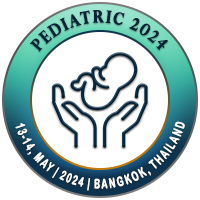
Nelli Prikhodchenko
Pacific State Medical University, RussiaTitle: Sensitization to cow milk components in children with different phenotypes and endotypes of food allergy
Abstract
Background: The variety of causes of the food allergy development, complex pathogenesis, and the unequal response of patients to therapy have led to the identification of phenotypes and endotypes of allergic diseases. Studies on the study of food allergy phenotypes and endotypes are rare.
Method: 216 children with cow's milk allergy (CMA) were examined to study the frequency of sIgE to cow's milk protein and its fractions. sIgE was determined by the Immunocap method. IgE-mediated CMA was confirmed in 68.5% of children (n = 148), non-IgE-mediated - in 31.5% of children (n = 68). It was revealed that in most children (n = 87, 58.8%) sensitization was determined to nBos d 8, in 45.9% of cases to nBos d 4 (n = 68).
Results: The conducted clinical and laboratory analysis allowed us to isolate the skin, gastrointestinal, and mixed phenotype CMA in children. The skin phenotype (SPh, n = 72, 33.3%) was characterized by an isolated lesion of the skin. Ig E positive endotype prevailed and was determined in 54 children (75% among children with SPh), the average level of total Ig E was 27.16 +3.68 kUA / l. No sIgE for cow's milk protein and its fractions (Ig E negative endotype) were detected in 28 children with SPh. The gastrointestinal phenotype (GIPh, n = 46, 21.3%) was characterized by an isolated lesion of the gastrointestinal tract. This phenotype was represented predominantly by Ig E negative endotype (71.7% among children with GIPh). Ig E positive endotype was determined in 13 children with GIPh (28.26%), the average level of total Ig E was 34.71 + 5.92 kUA / l. Mixed phenotype (MPh) prevailed in our study, n = 98 (45.4%) and was characterized by a combination of skin and gastrointestinal manifestations, 7 children have symptoms of skin, gastrointestinal tract lesions and respiratory manifestations. Ig E positive endotype prevailed, it was determined in 81 children with MPh (82.7%), the average level of total Ig E was 21.58 + 5.24 kUA / l. The analysis showed that sensitization to nBos d 4 has the greatest value on the formation of the GIPh. In the formation of skin manifestations in children with SPh and MPh, the combined sensitization to nBos d 8 and nBos d 6, as well as the combination nBos d 8 and nBos d 5.
Conclusion: Selection of individual phenotypes of CMA will allow explaining the clinical, pathophysiological, functional features of each specific patient and choosing personalized therapy.
Biography
Will be updated soon.

